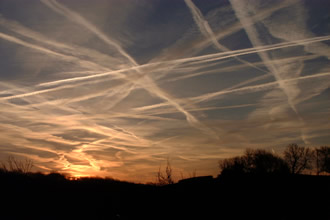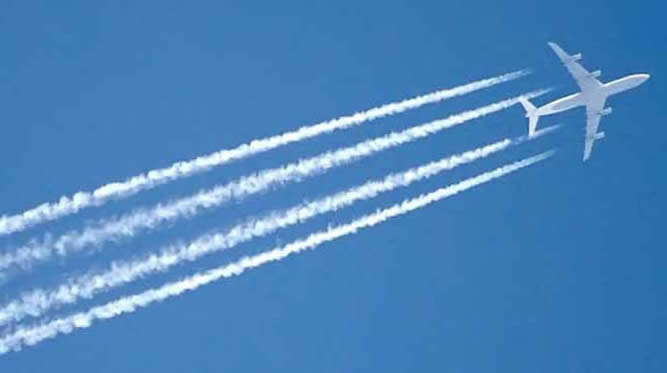The word Contrail stems from 'condensation' and 'trail'.
Aviation smog (that's what it really is) is caused by airtraffic at great heights. Each day, jetengines of airplanes dump vast amounts of water (ice), CO2, soot particles (condensation nuclei), aërosols and chemical substances. Airtraffic thus not only alters the properties of the higher regions of our troposphere but also all the regions below, right down to groundlevel. This extra layer of man-made high-altitude smog probably infuences weather, climate and the quality and quantity of the sun's radiation that reaches the surface of Earth ("global dimming."). Aviation-smog is responsible for more clouds, rain, drought, bigger hailstones (megacryometeors), a stronger greenhouse effect (global warming), and, maybe, even gives extra power to hurricanes. Still, aviation-smog does not get the scientific and political attention it deserves
Contrails or vapor trails are condensation trails and artificial cirrus clouds made by the exhaust of aircraft engines or wingtip vortices which precipitate a stream of tiny ice crystals in moist, frigid upper air. Being composed of water, the visible white streams are not, in and of themselves, air pollution. However, contrails generated by engine exhaust are inevitably linked with typical fuel combustion pollutants.
Condensation from aircraft jet engine exhaust
The main products of hydrocarbon fuel combustion are carbon dioxide and water vapor. At high altitudes this water vapor emerges into a cold environment, and the local increase in water vapor can push the water content of the air past saturation point. The vapor then condenses into tiny water droplets and/or desublimates into ice. These millions of tiny water droplets and/or ice crystals form the contrails. The energy drop (and therefore, time and distance) the vapor needs to condense accounts for the contrail forming some way behind the aircraft's engines. The majority of the cloud content comes from water trapped in the surrounding air. At high altitudes, supercooled water vapor requires a trigger to encourage desublimation. The exhaust particles in the aircraft's exhaust act as this trigger, causing the trapped vapor to rapidly turn to ice crystals. Exhaust contrails usually occur at above 26,000 feet. where the temperature is below -40°C.
Condensation from decreases in pressure
The wings of an aircraft cause a drop in air pressure in the vicinity of the wing. This brings with it a drop in temperature, which can cause water to condense out of the air and form a contrail. This effect is commonly seen on humid days, on fighter jets performing high energy maneuvers or on airliners during takeoff and landing. Additionally, the area around a turbo-fan intake will be at a lower pressure than the surrounding air, and may result in a condensation fog forming there during high power settings.
Contrails and climate
Contrails, by affecting the Earth's radiation balance, act as a radiative forcing. Studies have found that contrails trap outgoing longwave radiation emitted by the Earth and atmosphere (positive radiative forcing) at a greater rate than they reflect incoming solar radiation (negative radiative forcing). Therefore, the overall net effect of contrails is positive, i.e. a warming. However, the effect varies daily and annually, and overall the magnitude of the forcing is not well known: globally (for 1992 air traffic conditions), values range from 3.5 mW/m² to 17 mW/m². Other studies have determined that night flights are most responsible for the warming effect: while accounting for only 25% of daily air traffic, they contribute 60 to 80% of contrail radiative forcing. Similarly, winter flights account for only 22% of annual air traffic, but contribute half of the annual mean radiative forcing.
September 11, 2001 climate impact study
It had been hypothesized that contrails may affect the weather, reducing solar heating during the day and radiation of heat during the night by increasing the albedo. The suspension of air travel for three days in the United States after September 11, 2001 provided an opportunity to test this hypothesis. Measurements did show that without contrails the local diurnal temperature range (difference of day and night temperatures) was about 1 degree Celsius higher than immediately before; however, it has also been suggested that this was due to unusually clear weather during the period.
Distrails
Where an aircraft passes through a cloud, it can clear a path through it; this is known as a distrail.
Aurora aircraft are hypothesized high-technology Black project aircraft which leave "donuts-on-a-rope" contrails. |







